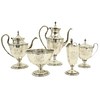The Paintings Of William Blake, Figgis 1925.
This book is titled “The Paintings Of William Blake” by Darrell Figgis and published in New York in 1925 by Charles Scribner’s Sons, and only 1150 copies were ever printed, of which 900 copies were reserved for the ordinary edition and 250 copies for the Edition de Luxe, which were numbered and printed on special paper and bound with pigskin, with an extra color plate thrown in and accompanied by a portfolio with an extra set of plates. This is one of the 900 ordinary copies.
The book is half-bound, the spine is white buckram with gilt lettering, the covers are thick papered boards with an enlarged photograph which appears to show twisted rope or chains, with the bookplate of Marylouise Corley on the front-paste-down of the blank endpapers, then the half-title, title page and limitation page, a dedication page to Millie for helping with the book being finished after twelve years of planning, the Contents page, a long List of Illustrations (ix - xv), followed by 117 pages about Blake’s life and 100 plates in color and in black and white; the plates also come with notes about each one, and an interesting way to look at Blake’s life through his paintings and works of art.
William Blake (1757 - 1827) was an English poet, painter, and printmaker. Largely unrecognized during his lifetime, Blake is now considered a seminal figure in the history of the Romantic Age. His visual artistry led 20th century critics to proclaim him "far and away the greatest artist Britain has ever produced”, and in 2002, Blake was placed at number 38 in the BBC poll of the 100 Greatest Britons. Blake was considered mad by his contemporaries for his idiosyncratic views, but he came to be highly regarded for
his expressiveness and creativity, and for the philosophical and mystical undercurrents within his work.
In 1788, when he was 31, Blake experimented with relief etching, a method he used
to produce most of his books, paintings, and poems. The process was referred to as illuminated printing, and the finished products as illuminated books or prints. Blake also employed intaglio engraving in his work, but his relief etchings were the most innovative aspect of his art, and he made frequent use of a technique known as "repoussage", a means of obliterating mistakes by hammering them out on the back of the plate.
Blake was not active in politics, but his poetry embodied an attitude of rebellion against power. Blake was concerned about senseless wars and the disruptive effects of the Industrial Revolution, and much of his poetry used symbolism and allegory to show the effects of the French and American revolutions; Blake was disillusioned with the politics and outcomes of the conflicts, believing they simply replaced monarchy with another form of government. Blake was deeply opposed to slavery and believed that some of his poems were interpreted to mean "free love" and lost some of their anti-slavery flavor because of that.
Some of his early work was a protest against dogmatic religion, and he was critical of
the marriage laws of his day and railed against traditional Christian notions of chastity
as a virtue. He also believed in racial and sexual equality.
Blake claimed to experience visions throughout his life; often associated with religious themes and imagery, they may have inspired his spiritual works and pursuits. Religious concepts and imagery figured centrally in Blake's works, and he believed he was personally instructed and encouraged by Archangels to create his artistic work. Yet despite seeing angels and God, Blake also claimed to see Satan on the staircase of his home in London. Some people said he was mad, but they also found a deep appeal in his works.
Blake had an enormous influence on beat poets of the 1950’s and the counterculture of the 1960’s, often cited by such figures as beat poet Allen Ginsberg, songwriters Bob Dylan, Jim Morrison, Van Morrison, and English writer Aldous Huxley.
The book is 4to. and measures 11 1/4 x 9 1/4 in. wide and is in pretty good condition. The binding is a little weak along the front gutter, other than that the binding is tight,
and the pages are pretty clean, with occasional brown spots, especially towards the endpapers. The spine has darkened a bit, the gilt is fading, and there are bumps at the heel and crown of the spine, with light rubbing at the edges and wear at the tips, but
the plates are all present and crisp. An interesting book about an interesting artist and printmaker who is now being appreciated more than when he was alive.
#217 #1551
Available payment options
We accept all major credit cards, wire transfers, money orders, checks and PayPal. Please give us a call at (941) 359-8700 or email us at SarasotaEstateAuction@gmail.com should you have any questions about payment.



















